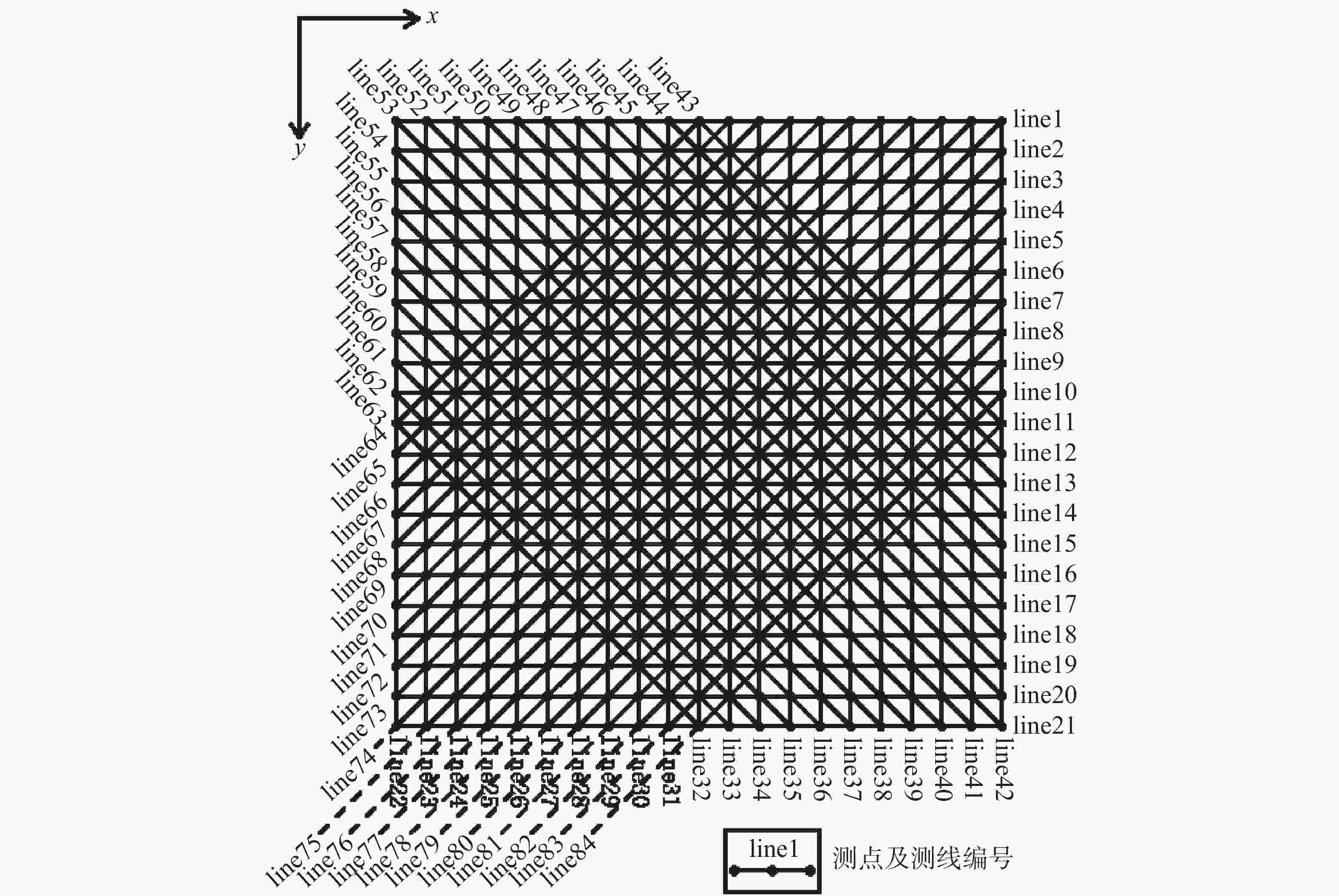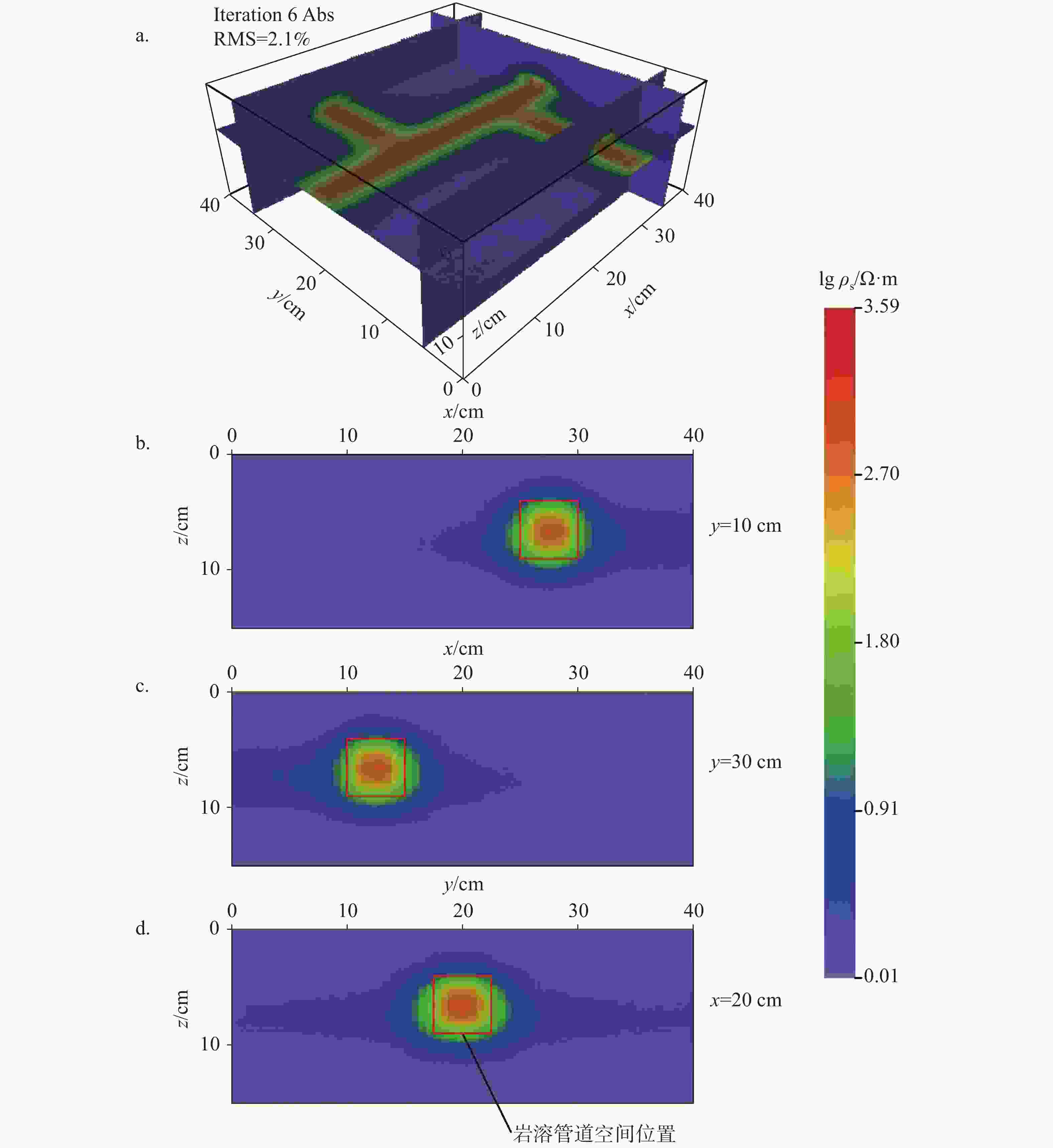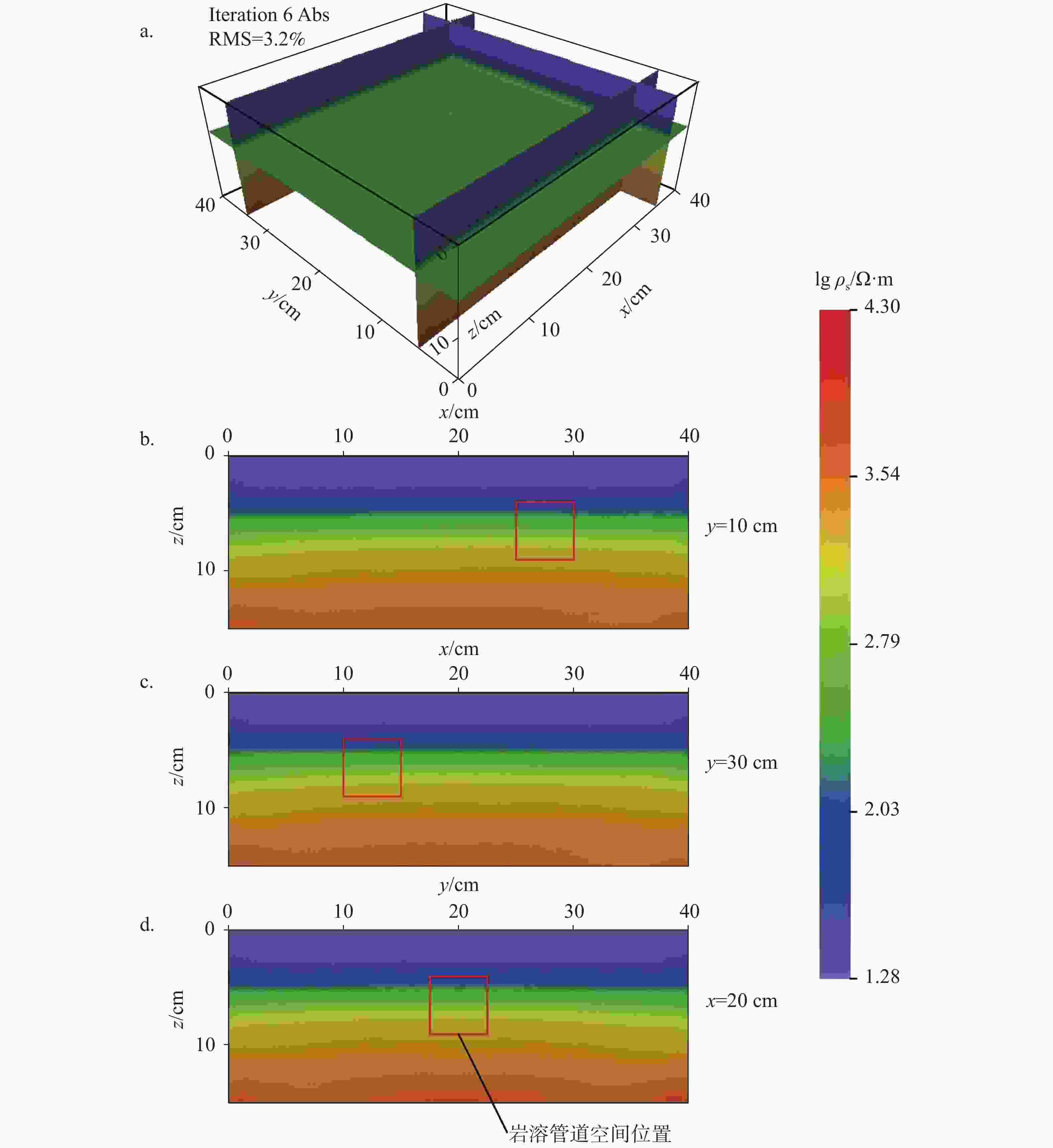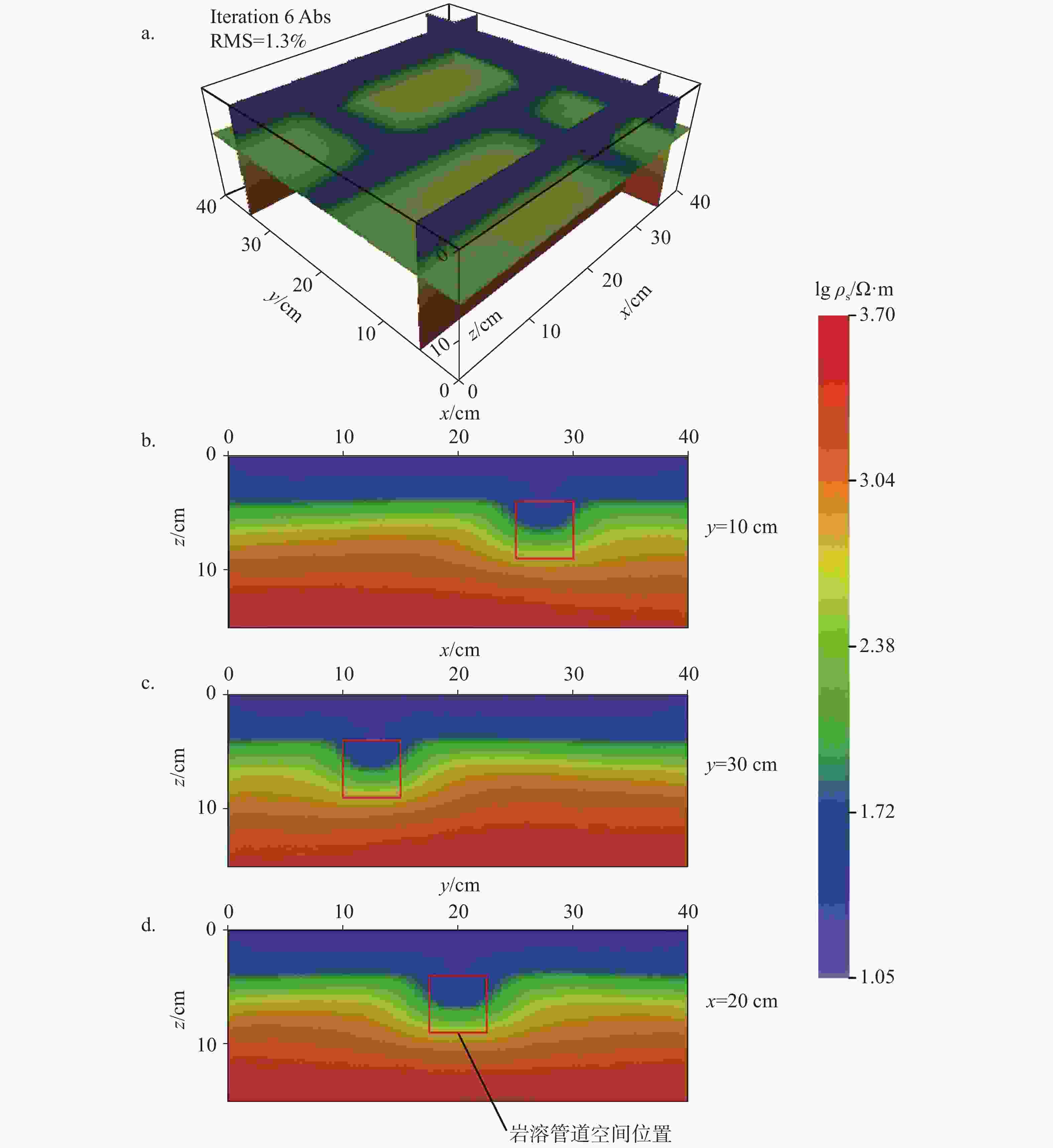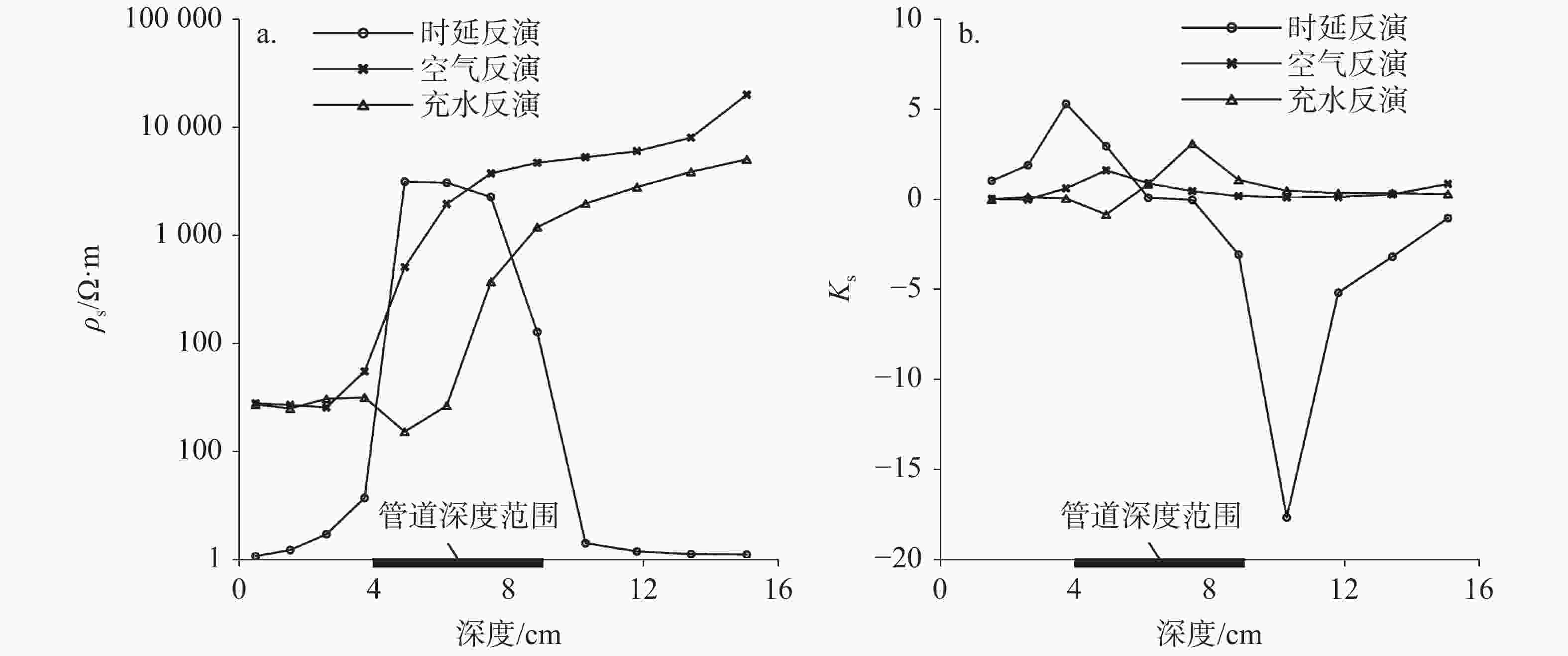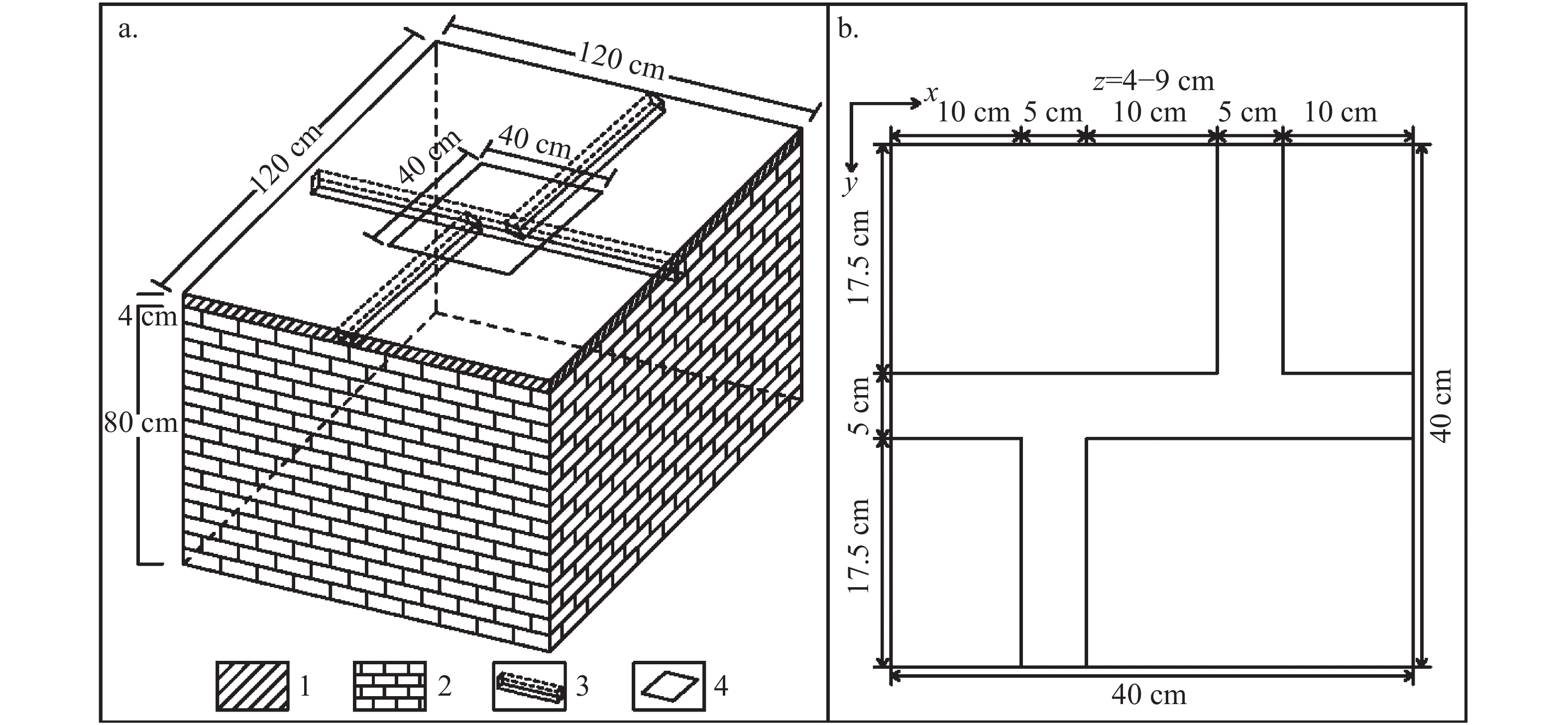Study on physical simulation of spatial distribution identification of karst underground pipeline based on time-lapse 3D resistivity inversion
-
摘要: 岩溶地下河管道空间分布的识别对岩溶区的各类地球科学工作意义重大,文章阐述了采用时延三维电阻率反演技术,开展对地下河管道空间分布识别的研究,在室内灰岩介质下的物理模拟实验结果表明:对雨季管道充水和枯季管道干涸时采集的电阻率数据进行时延反演后,地下河管道的模拟三维空间分布被很好地突显出来,时延反演效果大大地优于对单次采集数据的反演效果,管道充填水时的反演效果次之,管道充填空气时的反演结果很难有效识别地下河管道的空间分布情况。物理模型试验成果可指导野外实践中对岩溶地下河管道的探测研究。Abstract: The spatial distribution of karst underground river pipelines is complex and changeable; therefore, it is of great significance for us to carry out the earth science work in karst areas to develop an effective detection technology for the identification of pipelines. Based on the characteristics that karst underground river pipelines change greatly with seasons and time, the spatial distribution identification of underground river pipelines is studied by the inversion technology of time-lapse 3D resistivity. The results of pilot physical model experiments in limestone medium show that, the spatial distribution of simulated three-dimensional underground river pipeline is well highlighted according to the time-delay inversion imaging of resistivity data respectively collected from water-filled pipelines in rainy season and air-filled pipelines in dry season, The area with large resistivity change is in good agreement with the actual spatial position of pipeline in transverse and longitudinal directions. The closer the resistivity is to the center of the pipeline, the more significant the resistivity change is. In terms of the electrical sounding curve, the resistivity presents a low-high-low feature, and the resistivity contrast between pipeline space and other depth intervals is significant. In terms of the electrical sounding gradient curve, both the gradient value of pipeline space near the overlying clay layer and the value underlying limestone layer are large. The gradient value is positive near the upper contact surface and negative near the lower contact surface. The inversion effect with water-filled pipeline is inferior to that of time-lapse inversion. When the simulated pipeline is filled with water, the pipeline space presents relatively low resistivity. The resistivity value at the bottom of the pipeline is greater than that of the upper part, and the actual spatial position of the pipeline can be effectively reflected. The resistivity presents a high-low-high curve on the electrical sounding curve. However, on the electrical sounding gradient curve, the gradient value of the pipeline space near the overlying clay layer is negative, and it is positive near the underlying limestone layer. It is difficult to effectively identify the karst pipeline through the inversion images only generated by air-filled data. The resistivity rises monotonously and the resistivity value in the pipeline space changes more quickly than that in other depth intervals on the electrical sounding curve, while on the electrical sounding gradient curve, the resistivity gradient value in the pipeline space is slightly larger than that in other depth intervals, but the anomaly in the pipeline space is very weak compared with the time-lapse inversion results and water filling inversion results. It is suggested that when the spatial distribution of underground river pipelines in the field is studied, the 3D resistivity data should be collected in wet season and dry season, respectively, and the time-lapse 3D resistivity inversion image, electric sounding curve and electric sounding gradient curve can be comprehensively analyzed for the research. The subordinate choice is to carry out 3D detection of karst pipeline in wet season and analyze the data comprehensively, so as to obtain a practical detection technology that can effectively locate the underground river pipeline whether it is filled with water or free of water, which can be popularized and applied in practice.
-
图 3 时延三维电阻率反演成像成果图(模拟管道充填空气和水时的动态差异)
(a. 立体视角图,b. y=10 cm时xz方向切片,c. y=30 cm时xz方向切片,d. x=20 cm时yz方向切片)
Figure 3. Results of time-lapse 3D resistivity inversion (Dynamic difference of pipeline filling air and water)
(a. stereoscopic view, b. slice in xz direction, y=10 cm, c. slice in xz direction, y=30 cm, d. slice in yz direction, x=20 cm)
图 6 地下河管道中心处时延反演、充水反演以及充填空气反演时电阻率测深曲线对比图(x=20 cm, y=20 cm)
(a. 电阻率测深曲线, b. 电阻率测深梯度曲线)
Figure 6. Comparison curves of resistivity sounding between time-lapse inversion, water-filled inversion and air-filled inversion at the center of underground river pipeline (x=20 cm, y=20 cm)
(a. resistivity sounding curves, b. resistivity sounding gradient curves)
表 1 模型各介质电阻率参数表(通过小对称四极法测量)
Table 1. Resistivity of the medium in the model (Measured by the small symmetrical quadrupole method)
模型介质 电阻率/Ω.m 灰岩 5 850.48 上覆黏土 25.66 水 23.39 -
[1] 秦俭, 李身想. 浅谈南北方岩溶地貌差异成因[J]. 科技展望, 2014, 14(14):192. doi: 10.3969/j.issn.1672-8289.2014.14.169QIN Jian, LI Shenxiang. On the causes of karst landform differences between South and North[J]. Science and Technology, 2014, 14(14):192. doi: 10.3969/j.issn.1672-8289.2014.14.169 [2] 郭纯青. 中国岩溶地下河系及其水资源[J]. 水文地质工程地质, 2001, 28(5):43-45. doi: 10.3969/j.issn.1000-3665.2001.05.011GUO Chunqing. Karst underground river system and its water resources in China[J]. Hydrogeology & Engineering Geology, 2001, 28(5):43-45. doi: 10.3969/j.issn.1000-3665.2001.05.011 [3] 洛塔岩溶地质研究组. 洛塔岩溶及其水资源评价与利用的研究[M]. 北京: 地质出版社, 1984.Luota karst geological research group. Study on Luota karst and its water resources evaluation and utilization[M]. Beijing: Geological Publishing House, 1984. [4] 杨杨, 唐建生, 苏春田, 潘晓东, 赵良杰. 岩溶区多重介质水流模型研究进展[J]. 中国岩溶, 2014, 33(4):419-424.YANG Yang, TANG Jiansheng, SU Chuntian, PAN Xiaodong, ZHAO Liangjie. Research advance on multi-medium flow model for karst aquifers[J]. Carsologica Sinica, 2014, 33(4):419-424. [5] 徐中平, 周训, 崔相飞, 拓明明, 王昕昀. 岩溶区地下水数值模拟研究进展[J]. 中国岩溶, 2018, 37(4):475-483.XU Zhongping, ZHOU Xun, CUI Xiangfei, TUO Mingming, WANG Xinyun. Research advances of numerical simulation of groundwater in karst areas[J]. Carsologica Sinica, 2018, 37(4):475-483. [6] Bakalowicz M. Karst groundwater: a challenge for new resources[J]. Hydrogeology Journal, 2005, 13(1):148-160. doi: 10.1007/s10040-004-0402-9 [7] 常廷改. 岩溶塌陷型水库地震的形成条件分析[J]. 水文地质工程地质, 2006, 33(5):42-45. doi: 10.3969/j.issn.1000-3665.2006.05.010CHANG Tinggai. Forming conditions of karst collapsing induced earthquake[J]. Hydrogeology & Engineering Geology, 2006, 33(5):42-45. doi: 10.3969/j.issn.1000-3665.2006.05.010 [8] 雷明堂, 李瑜, 蒋小珍, 甘伏平, 蒙彦. 岩溶塌陷灾害监测预报技术与方法初步研究:以桂林市柘木村岩溶塌陷监测为例[J]. 中国地质灾害与防治学报, 2004, S1:148-152.LEI Mingtang, LI Yu, JIANG Xiaozhen, GAN Fuping, MENG Yan. Preliminary study on the technology and method of sinkhole collapse monitoring and prediction—As an example of sinkhole collapse monitoring station in Zhemu Village, Guilin City[J]. The Chinese Journal of Geological Hazard and Control, 2004, S1:148-152. [9] Gabrovsek F, Stepisnik U. On the formation of collapse dolines: A modelling perspective[J]. Geomorphology, 2011, 134(1-2):23-31. doi: 10.1016/j.geomorph.2011.06.007 [10] 裴建国. 广西溶洼系统结构特征及其对岩溶内涝的影响[J]. 广西科学, 2002, 9(3):193-197. doi: 10.3969/j.issn.1005-9164.2002.03.011PEI Jianguo. The structure characteristic of karst depression system and its effect on karst depression waterlogging[J]. Guangxi Sciences, 2002, 9(3):193-197. doi: 10.3969/j.issn.1005-9164.2002.03.011 [11] 黄秀凤. 坡心地下河流域岩溶内涝成因分析与防治对策[J]. 安全与环境工程, 2014, 21(6):42-46,91. doi: 10.3969/j.issn.1671-1556.2014.06.008HUANG Xiufeng. Causes of and countermeasures for karst waterlogging in Poxin underground river basin[J]. Safety and Environmental Engineering, 2014, 21(6):42-46,91. doi: 10.3969/j.issn.1671-1556.2014.06.008 [12] Zeng J, Huang G. Set pair analysis for karst waterlogging risk assessment based on ahp and entropy weight[J]. Nordic hydrology, 2018, 49(3-4):1143-1155. [13] 屈昌华. 中小型水库坝基岩溶管道渗漏勘察与处理实例[J]. 探矿工程(岩土钻掘工程), 2007, 34(10):60-61.QU Changhua. Investigation and treatment of seepage in bedrock solution pipeline of small and medium-sized reservoir dam[J]. Exploration Engineering(Rock & Soil Drilling and Tunneling), 2007, 34(10):60-61. [14] 余加松, 孙明彪, 王太银. 贵州省三宝水库岩溶渗漏分析[J]. 地下水, 2020, 42(4):241-242.YU Jiasong, SUN Mingbiao, WANG Taiyin. Analysis on karst leakage of Sanbao reservoir in Guizhou Province[J]. Groundwater, 2020, 42(4):241-242. [15] Gutiérrez F, Mozafari M, Carbonel D, Gomez R, Raeisi E. Leakage problems in dams built on evaporites. The case of La Loteta Dam (NE Spain), a reservoir in a large karstic depression generated by interstratal salt dissolution[J]. Engineering Geology, 2015, 185:139-154. doi: 10.1016/j.enggeo.2014.12.009 [16] 赵小二, 常勇, 吴吉春. 岩溶地下河污染物运移模型对比研究[J]. 环境科学学报, 2020, 40(4):1250-1259.ZHAO Xiao’er, CHANG Yong, WU Jichun. A comparative study on two contaminant transport models used in karst underground rivers[J]. Acta Scientiae Circumstantiae, 2020, 40(4):1250-1259. [17] 陈余道, 程亚平, 蒋亚萍, 林鹏, 蒋灵芝. 岩溶地下河反硝化作用的有限性:一个碳酸盐岩管道的实验研究[J]. 环境科学学报, 2016, 36(10):3629-3635.CHEN Yudao, CHENG Yaping, JIANG Yaping, LIN Peng, JIANG Linzhi. Limitation of denitrification in karst subterranean river: A carbonate-conduit experimental study[J]. Acta Scientiae Circumstantiae, 2016, 36(10):3629-3635. [18] 钟春里. 岩溶管道系统中污染物扩散及地下水自净能力研究:贵州某磷石膏堆场为例[J]. 贵州地质, 2011, 28(2):126-130. doi: 10.3969/j.issn.1000-5943.2011.02.010ZHONG Chunli. Study of pollutant dispersion and underground water self-purification capacity in the karst conduit system:phosphogypsum gradient in Guizhou as the example[J]. Guizhou Geology, 2011, 28(2):126-130. doi: 10.3969/j.issn.1000-5943.2011.02.010 [19] Gan F, Han K, Lan F, Chen Y, Zhang W. Multi-geophysical approaches to detect karst channels underground :A case study in Mengzi of Yunnan Province, China[J]. Journal of Applied Geophysics, 2017, 136:91-98. doi: 10.1016/j.jappgeo.2016.10.036 [20] 陈玉玲, 甘伏平, 卢呈杰, 韦吉益, 赵伟. 裸露岩溶区地下河管道综合地球物理方法探测研究[J]. 地球物理学进展, 2013, 28(3):1608-1616.CHEN Yuling, GAN Fuping, LU Chengjie, WEI Jiyi, ZHAO Wei. The Study of underground river course detection by integrated geophysical methods in bare karst area[J]. Progress in Geophysics, 2013, 28(3):1608-1616. [21] 甘伏平, 喻立平, 黎华清, 卢呈杰, 韦吉益. 利用综合物探方法探测地下水流通道[J]. 地质与资源, 2010, 19(3):262-266. doi: 10.3969/j.issn.1671-1947.2010.03.014GAN Fuping, YU Liping, LI Huaqing, LU Chengjie, WEI Jiyi. Detection of groundwater conduits by integrated geophysical methods[J]. Geology and Resources, 2010, 19(3):262-266. doi: 10.3969/j.issn.1671-1947.2010.03.014 [22] Chalikakis K, Plagnes V, Guerin R, Valois R, Frank B. Contribution of geophysical methods to karst-system exploration: an overview[J]. Hydrogeology Journal, 2011, 19(6):1169-1180. doi: 10.1007/s10040-011-0746-x [23] 张欣, 赵明阶, 汪魁, 荣耀, 刘强. 电法三维成像技术在隧道岩溶探测中的应用[J]. 中国岩溶, 2016, 35(3):291-298.ZHANG Xin, ZHAO Mingjie, WANG Kui, RONG Yao, LIU Qiang. Application of 3D electrical resistivity tomography to a tunnel in a karst area[J]. Carsologica Sinica, 2016, 35(3):291-298. [24] 高阳, 熊华山, 彭明涛, 江兆南, 范飞越. 三维高密度电法技术及其在岩溶塌陷勘探中的应用[J]. 桂林理工大学学报, 2017, 37(3):417-421. doi: 10.3969/j.issn.1674-9057.2017.03.004GAO Yang, XIONG Huashan, PENG Mingtao, JIANG Zhaonan, FAN Feiyue. Three-dimensional high-density electrical technique and application of geophysical prospecting to karst collapse[J]. Journal of Guilin University of Technology, 2017, 37(3):417-421. doi: 10.3969/j.issn.1674-9057.2017.03.004 [25] 周启友, 杭悦宇, 刘汉乐, 戴水汉, 徐建平. 饱水和排水过程中岩石电阻率各向异性特征的电阻率成像法研究[J]. 地球物理学报, 2009, 52(1): 281-288.ZHOU Qiyou, HANG Yueyu, LIU Hanle, DAI Shuihan, XU Jianping. The anisotropic properties of rock resistivity during saturation and desaturation processes revealed by electrical resistivity tomography[J]. Chinese Journal of Geophysics, 2009,52(1) : 281-288. [26] Ellis R G, Oldenburg D W. Applied geophysical inversion[J]. Geophysical Journal International, 1994, 116:5-11. doi: 10.1111/j.1365-246X.1994.tb02122.x [27] Loke M H. Electrical Resistivity Surveys and Data Interpretation[M]. Springer Netherlands, 2011. [28] Kim J H, Yi M J, Park S G, Kim J G. 4-D inversion of DC resistivity monitoring data acquired over a dynamically changing earth model[J]. Journal of Applied Geophysics, 2009, 68(4):522-532. doi: 10.1016/j.jappgeo.2009.03.002 [29] Loke M H, Dahlin T, Rucker D F. Smoothness-constrained time-lapse inversion of data from 3D resistivity surveys[J]. Near Surface Geophysics, 2014, 12(2007):5-24. [30] Loke M H. Rapid 3-D Resistivity & IP inversion using the least-squares method[M]. 2015. Available at www. geotomosoft. com. [31] Loke M H, Acworth I, Dahlin T. A comparison of smooth and blocky inversion methods in 2D electrical imaging surveys[J]. Exploration Geophysics, 2003, 34(3):182-187. doi: 10.1071/EG03182 [32] 郭秀军, 王兴泰. 用高密度电阻率法进行空洞探测的几个问题[J]. 物探与化探, 2001, 25(4):306-311,315.GUO Xiujun, WANG Xingtai. The application of geological radar in media of different lithologic characters[J]. Geophysical & Geochemical Explaration, 2001, 25(4):306-311,315. [33] 崔锡钦. 利用高密度电阻率法进行空洞探测的研究[D]. 青岛:中国海洋大学, 2003.CUI Xiqin. Study of the hole exploration with high density resistivity [D]. Qingdao: Ocean University of China, 2003. -




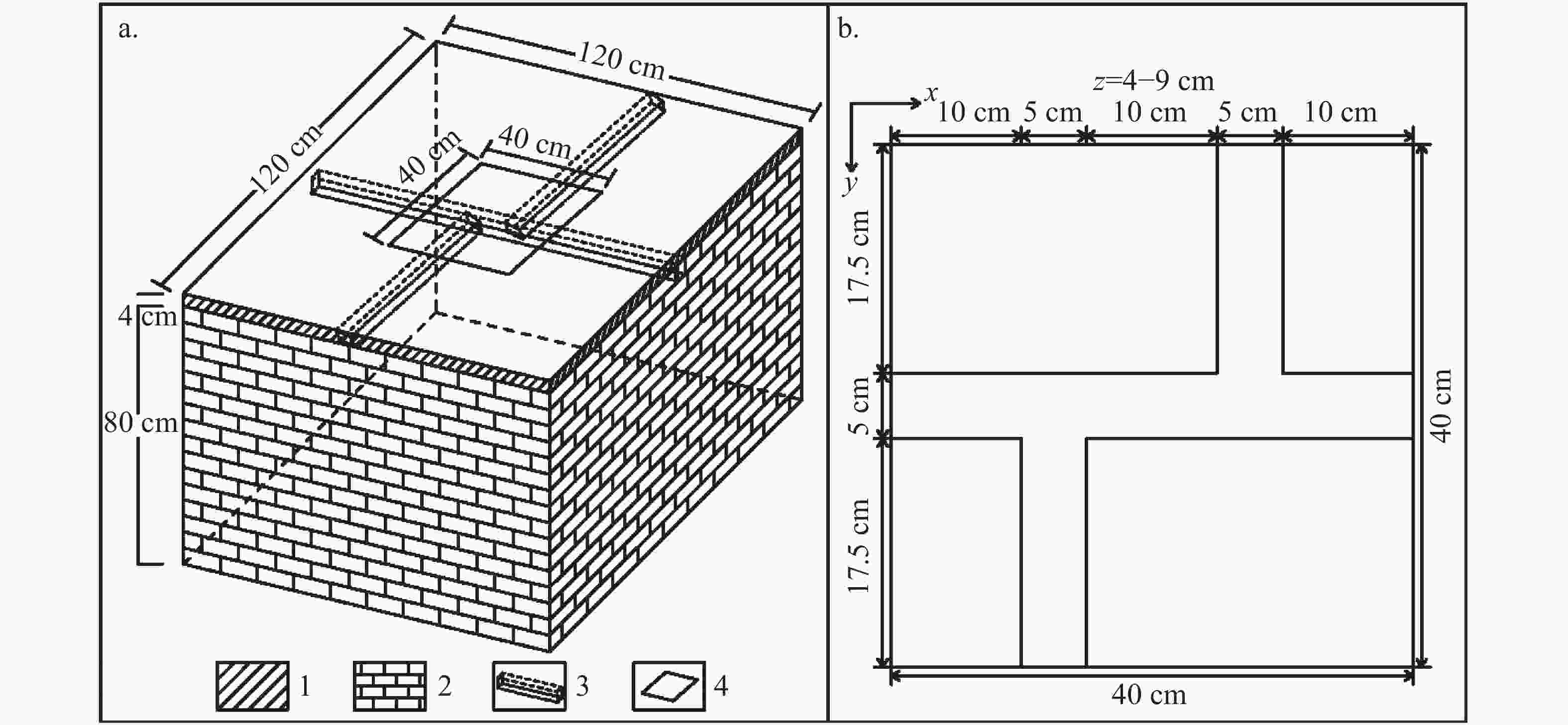
 下载:
下载:
